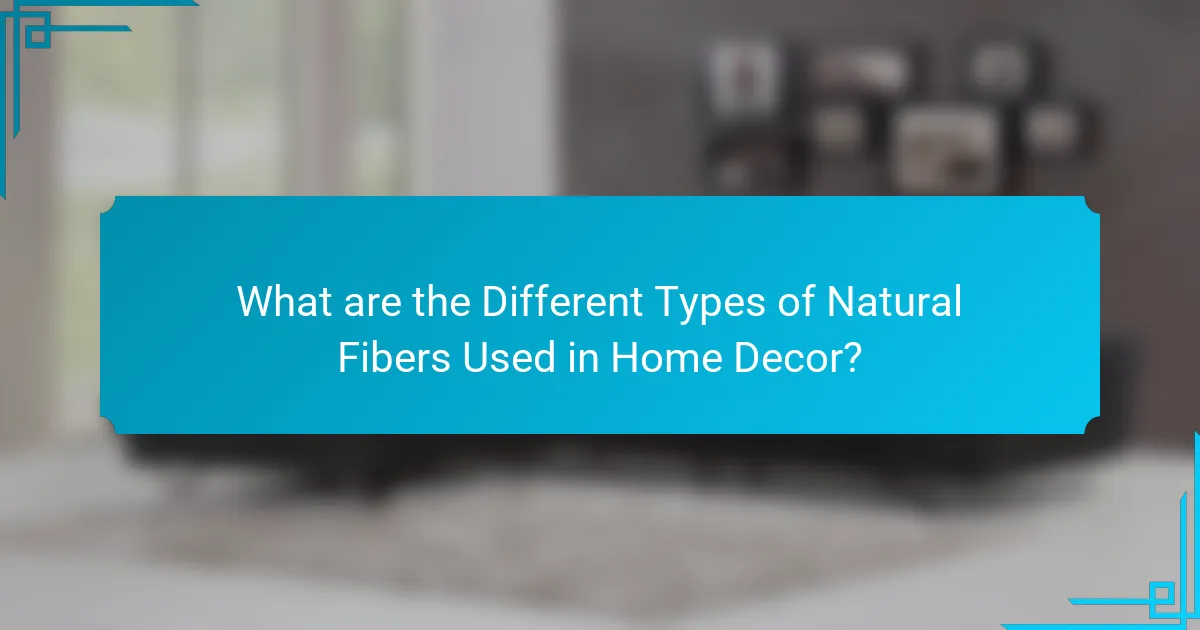Natural fibers, derived from plants, animals, or minerals, are biodegradable and sustainable materials that enhance home decor. Common types include cotton, linen, jute, wool, and silk, each contributing unique textures and aesthetics to interiors. These fibers are not only visually appealing but also promote environmental sustainability by improving air quality and being renewable. The article explores the benefits of using natural fibers in home decor, detailing their various types and offering practical design ideas for incorporating them into living spaces, such as rugs, curtains, and upholstery.

What are Natural Fibers and Their Role in Home Decor?
Natural fibers are materials derived from plants, animals, or minerals that are biodegradable and sustainable. Common examples include cotton, linen, jute, wool, and silk. These fibers play a significant role in home decor by adding texture, warmth, and a natural aesthetic to interiors. They are often used in textiles such as rugs, curtains, and upholstery. Natural fibers contribute to environmental sustainability due to their renewable nature. Additionally, they often provide better air quality compared to synthetic materials. The use of natural fibers can enhance the overall ambiance of a space, making it feel more inviting and comfortable.
How do natural fibers differ from synthetic fibers?
Natural fibers are derived from plants or animals, while synthetic fibers are man-made through chemical processes. Natural fibers include cotton, wool, and jute. These fibers are biodegradable and often have a smaller environmental footprint. Synthetic fibers, such as polyester and nylon, are durable and resistant to wrinkles. However, they can take hundreds of years to decompose. Natural fibers tend to be more breathable and comfortable against the skin. In contrast, synthetic fibers can be more water-resistant and stain-resistant. The choice between them often depends on the intended use and desired properties in home decor.
What are the most common types of natural fibers used in home decor?
The most common types of natural fibers used in home decor include cotton, linen, jute, hemp, and wool. Cotton is widely appreciated for its softness and versatility. Linen, made from flax, is known for its durability and breathability. Jute is a sustainable option, often used in rugs and curtains, due to its coarse texture. Hemp is recognized for its strength and eco-friendliness. Wool is valued for its warmth and texture, making it ideal for upholstery and blankets. These fibers are favored in home decor for their natural aesthetic and functional properties.
Why is the choice of fiber important for home decor?
The choice of fiber is important for home decor because it affects aesthetics, durability, and sustainability. Different fibers contribute unique textures and colors to a space. For instance, natural fibers like cotton and linen offer breathability and softness. Synthetic fibers may provide enhanced durability but can lack the warmth of natural options. The choice also impacts the environmental footprint of decor items. Sustainable fibers, such as jute or hemp, are biodegradable and renewable. Research shows that using natural fibers can improve indoor air quality. A study by the University of California found that natural materials can reduce volatile organic compounds in homes. Therefore, selecting the right fiber enhances both the visual appeal and ecological responsibility of home decor.
What benefits do natural fibers offer in home decor?
Natural fibers offer several benefits in home decor. They provide a sustainable option that is biodegradable and eco-friendly. Natural fibers, such as cotton, wool, and jute, are often more breathable than synthetic materials. This breathability contributes to better indoor air quality. Additionally, natural fibers have unique textures that add warmth and character to spaces. They also tend to be durable, making them suitable for high-traffic areas. Furthermore, natural fibers can help regulate temperature and humidity, enhancing comfort. Their aesthetic versatility allows them to fit various design styles, from rustic to modern.
How do natural fibers contribute to sustainability in home decor?
Natural fibers contribute to sustainability in home decor by being biodegradable and renewable. They come from plants and animals, making them a more eco-friendly option compared to synthetic materials. For example, cotton, jute, and wool are all natural fibers that decompose naturally over time. This reduces landfill waste and environmental impact. Additionally, natural fibers often require less energy to produce than synthetic fibers. The production of natural fibers typically uses fewer harmful chemicals, promoting healthier indoor air quality. Their durability can lead to longer-lasting products, further reducing the need for replacements. Overall, using natural fibers supports sustainable practices in home decor.
What health benefits are associated with using natural fibers in the home?
Natural fibers in the home offer several health benefits. They are hypoallergenic, reducing the risk of allergies and asthma. Natural fibers like cotton and wool are breathable, promoting better air quality. They help regulate humidity levels, which can prevent mold growth. Additionally, these materials are often free from harmful chemicals found in synthetic fibers. Using natural fibers can also enhance comfort, contributing to overall well-being. Studies show that homes with natural materials can lead to improved mental health. Overall, incorporating natural fibers supports a healthier living environment.
How do natural fibers enhance the aesthetic appeal of home decor?
Natural fibers enhance the aesthetic appeal of home decor by providing texture, warmth, and a natural look. They include materials like cotton, jute, and linen. These fibers create an inviting atmosphere through their organic appearance. Textures from natural fibers add depth to spaces. For example, woven jute rugs can soften a room’s feel. Natural colors and patterns in these materials promote a calming ambiance. Studies show that homes with natural elements foster relaxation. Incorporating natural fibers can elevate design while maintaining sustainability.
What design styles complement natural fibers in decor?
Bohemian, Scandinavian, and Coastal design styles complement natural fibers in decor. Bohemian style embraces eclectic patterns and textures, enhancing the organic feel of natural fibers. Scandinavian design focuses on minimalism and functionality, allowing natural fibers to add warmth and texture. Coastal style incorporates light colors and airy spaces, making natural fibers like jute and linen ideal for creating a relaxed atmosphere. These styles highlight the aesthetic and tactile qualities of natural materials, promoting a harmonious and inviting home environment.
How can natural fibers influence the overall ambiance of a space?
Natural fibers can significantly enhance the overall ambiance of a space. They bring warmth and texture, creating a cozy and inviting atmosphere. Materials like cotton, linen, and wool add a touch of nature indoors. These fibers are also breathable, which contributes to a comfortable living environment. Natural fibers often have unique patterns and colors, enriching visual interest. Their sustainability aspect promotes an eco-friendly ambiance. Studies show that natural materials can positively affect mood and well-being. For instance, a study by the University of Oregon found that natural elements in decor reduce stress and increase comfort levels.

What are the Different Types of Natural Fibers Used in Home Decor?
The different types of natural fibers used in home decor include cotton, linen, jute, hemp, and wool. Cotton is soft and widely used for upholstery and curtains. Linen is known for its durability and breathability, making it ideal for tablecloths and bedding. Jute is a coarse fiber often used in rugs and baskets due to its strength. Hemp is environmentally friendly and used in various textiles and wall coverings. Wool is valued for its warmth and texture, commonly found in blankets and carpets. These fibers are popular for their aesthetic appeal and sustainability.
What are the characteristics of popular natural fibers?
Popular natural fibers have distinct characteristics that make them suitable for various applications. Cotton is soft, breathable, and highly absorbent. Linen is known for its strength, durability, and natural luster. Jute is coarse, biodegradable, and often used in eco-friendly products. Hemp is exceptionally strong, resistant to mold, and has a low environmental impact. Wool provides insulation, is moisture-wicking, and has natural elasticity. Silk is smooth, luxurious, and has a natural sheen. Each fiber’s unique attributes contribute to its specific uses in home decor. For instance, cotton’s softness makes it ideal for bedding, while jute’s durability suits rugs and bags.
What are the unique attributes of cotton as a natural fiber?
Cotton has several unique attributes as a natural fiber. It is known for its softness, making it comfortable against the skin. Cotton is highly absorbent, allowing it to wick moisture away effectively. This fiber is also breathable, promoting airflow and reducing heat retention. Cotton is durable, withstanding repeated washing and wear. It is hypoallergenic, making it suitable for sensitive skin. Additionally, cotton can be dyed easily, offering a wide range of color options. Its biodegradability contributes to environmental sustainability. These attributes make cotton a popular choice for textiles in home decor.
How does wool compare to other natural fibers in home decor?
Wool is highly valued in home decor for its durability and insulation properties. Compared to other natural fibers like cotton and linen, wool offers superior warmth and resilience. It naturally repels water and dirt, making it easier to maintain. Wool also has a unique ability to regulate humidity, contributing to a comfortable indoor environment. In contrast, cotton is more absorbent but less durable, while linen is prone to wrinkling. Studies show that wool can last for decades with proper care, significantly outlasting many other natural fibers. This longevity makes wool a cost-effective choice for home decor.
What are the applications of different natural fibers in home decor?
Natural fibers are widely used in home decor for their aesthetic appeal and sustainability. Common applications include textiles for upholstery, curtains, and rugs. Jute is often used for rugs and wall hangings due to its durability. Cotton serves as a versatile fabric for cushions and throws, offering comfort and breathability. Linen, known for its texture, is popular for tablecloths and curtains. Bamboo is utilized in furniture and decorative items for its strength and eco-friendliness. Sisal is favored for its robust rugs and mats, adding a natural touch to spaces. These applications highlight the versatility and eco-conscious benefits of natural fibers in home decor.
How can jute be used in rugs and upholstery?
Jute can be used in rugs and upholstery due to its durability and natural aesthetic. Rugs made from jute are often woven, providing a textured surface. These rugs are biodegradable and eco-friendly, making them a sustainable choice. Upholstery can also feature jute as a fabric, offering a rustic look. Jute upholstery is strong and resistant to wear, suitable for various furniture types. Its natural fibers can be dyed, allowing for diverse color options. Additionally, jute blends well with other materials, enhancing its versatility in design. The use of jute in home decor promotes a connection to nature and supports sustainable practices.
What role does linen play in curtains and tablecloths?
Linen serves as a durable and breathable fabric for curtains and tablecloths. Its natural fibers allow for excellent airflow and light diffusion. This makes linen curtains ideal for creating a soft, inviting atmosphere. Additionally, linen tablecloths offer a sophisticated look while resisting wrinkles. The fabric’s absorbency helps in managing spills effectively. Linen also has a natural luster that enhances aesthetic appeal. Its eco-friendly properties contribute to sustainable home decor choices. Overall, linen combines functionality with style in various home settings.

What Design Ideas Incorporate Natural Fibers in Home Decor?
Natural fibers can be incorporated into home decor through various design ideas. Rugs made from jute or sisal add texture and warmth to living spaces. Woven baskets crafted from seagrass serve as both storage and decorative elements. Linen curtains provide a light, airy feel while allowing natural light to filter through. Cushions filled with cotton or wool offer comfort and style. Wall hangings made from macramé or natural fibers create visual interest and depth. Furniture upholstered in hemp or organic cotton enhances sustainability in design. Table runners and placemats made from bamboo or linen add an organic touch to dining areas. These ideas highlight the versatility and aesthetic appeal of natural fibers in home decor.
How can I effectively use natural fibers in my home design?
Incorporate natural fibers by selecting materials like cotton, jute, and linen for textiles. Use cotton for curtains and upholstery to enhance comfort and breathability. Jute works well for rugs and baskets, adding texture and warmth to spaces. Linen is ideal for tablecloths and cushions, offering elegance and durability. Implement these fibers in various forms, such as wall hangings or decorative pillows, to create a cohesive look. Natural fibers are sustainable and biodegradable, making them environmentally friendly choices. Studies show that using natural materials can improve indoor air quality by reducing toxins.
What are some creative ways to incorporate natural fiber textiles?
Natural fiber textiles can be creatively incorporated into home decor through various methods. Use them as upholstery for furniture to add texture and warmth. Create statement curtains from linen or cotton for an organic feel. Incorporate woven rugs to enhance comfort and visual interest. Use natural fiber cushions to add color and pattern to seating areas. Implement table runners or placemats made from jute or hemp for a rustic touch. Hang wall art crafted from macrame or woven fibers for a unique aesthetic. Finally, create decorative baskets from seagrass or rattan for both storage and style. These methods leverage the durability and aesthetic appeal of natural fibers in home decor.
How can natural fibers be combined with other materials in decor?
Natural fibers can be combined with other materials in decor through layering, weaving, and contrasting textures. For instance, jute rugs can complement wooden furniture, adding warmth and natural appeal. Linen cushions can enhance the softness of leather sofas, creating a balanced aesthetic. Additionally, natural fibers like cotton can be used in conjunction with synthetic fabrics for durability while maintaining a natural look. This combination fosters a unique visual interest and tactile experience in decor. Studies show that using natural fibers alongside other materials can improve indoor air quality and overall ambiance.
What are some popular trends in using natural fibers for home decor?
Popular trends in using natural fibers for home decor include the use of jute, cotton, and linen. Jute rugs and baskets are increasingly favored for their eco-friendliness and durability. Cotton is often utilized in throw pillows and curtains for its softness and versatility. Linen is gaining popularity for its breathable quality, often found in tablecloths and bedding. Sustainable sourcing of these materials is a significant trend, aligning with eco-conscious consumer preferences. Textured finishes and earthy color palettes are also prevalent, enhancing the organic aesthetic in interiors. These trends reflect a growing appreciation for sustainability and natural elements in home design.
How is minimalism influencing the use of natural fibers in design?
Minimalism is influencing the use of natural fibers in design by prioritizing simplicity and functionality. This design philosophy emphasizes clean lines and uncluttered spaces. Natural fibers such as cotton, linen, and jute align well with these principles. They offer a tactile quality that enhances the sensory experience of minimalistic spaces. Additionally, the sustainable nature of natural fibers appeals to eco-conscious consumers. Their versatility allows for seamless integration into various design styles. Research shows that minimalist interiors often feature fewer, high-quality materials. This trend encourages the use of natural fibers as a focal point rather than mere background elements.
What are the emerging styles that favor natural fibers in home decor?
Emerging styles that favor natural fibers in home decor include biophilic design, Scandinavian minimalism, and eco-chic aesthetics. Biophilic design emphasizes a connection to nature through organic materials. This style often incorporates jute, hemp, and cotton. Scandinavian minimalism values simplicity and functionality, featuring wool and linen in textiles. Eco-chic aesthetics prioritize sustainability, using recycled natural fibers. These styles reflect a growing trend towards eco-conscious living. According to a 2022 report by the Global Sustainability Institute, consumer interest in sustainable materials has increased by 30%. This shift influences home decor choices significantly.
What practical tips can I follow when using natural fibers in home decor?
Choose appropriate natural fibers for your home decor. Common options include cotton, linen, jute, and wool. Consider the texture and durability of each fiber. For example, jute is sturdy, making it ideal for rugs. Use cotton and linen for soft furnishings like curtains and cushions. Incorporate natural fibers into various elements, such as wall hangings and furniture. Layer different textures to create visual interest. Maintain the fibers properly by following care instructions. Regular cleaning will prolong their lifespan. Additionally, use natural fibers in sustainable designs to enhance eco-friendliness.
Natural fibers, derived from plants, animals, or minerals, play a crucial role in home decor by offering sustainability, aesthetic appeal, and health benefits. This article explores the various types of natural fibers such as cotton, linen, jute, wool, and hemp, highlighting their unique attributes and applications in textiles, rugs, and upholstery. It also examines the differences between natural and synthetic fibers, the importance of fiber choice for durability and environmental impact, and practical design ideas for incorporating natural fibers into home decor. Additionally, the article discusses emerging trends and styles that favor natural materials in the context of eco-friendly design.